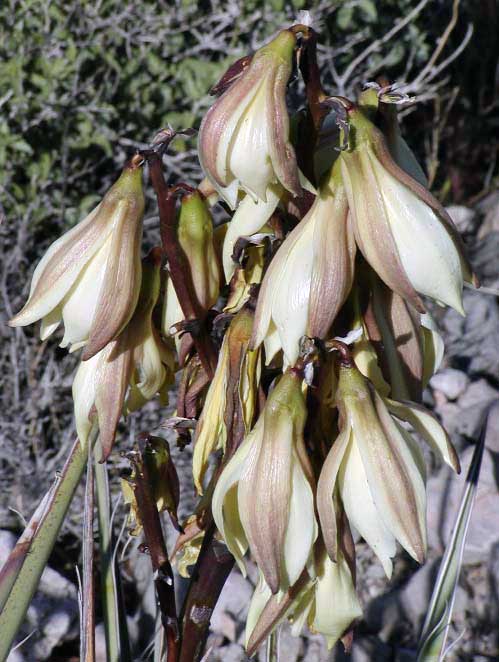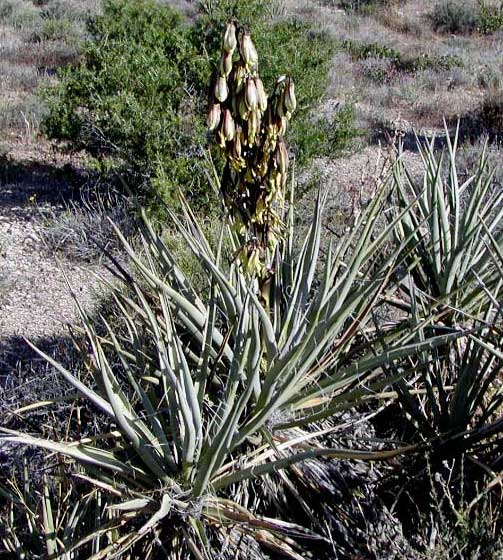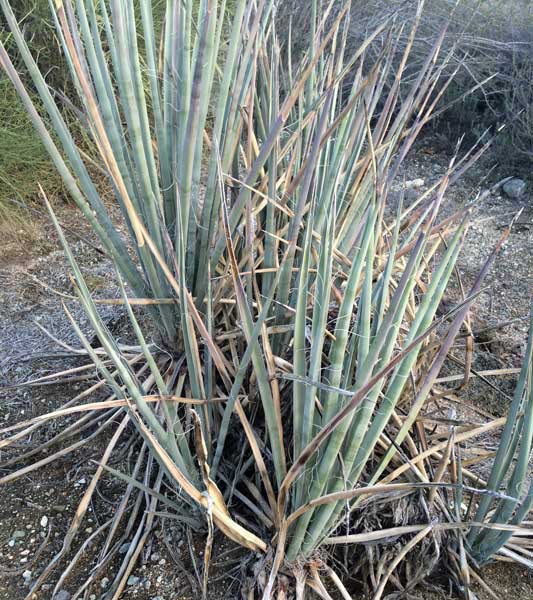Ethnobotany of southern California native plants:
Banana Yucca (Yucca baccata)

credit:Stan Shebs GFDL, CC BY-SA 3.0
Cream-white flowers sitting on top of the banana yucca stalk.

credit:Stan Shebs, CC BY-SA 2.5, via Wikimedia Commons
The stalk of the banana yucca rises considerably less than the mojave yucca.
Banana Yucca (Yucca baccata)
Banana yucca, also known as datil yucca, is a common yucca plant in the Mojave and Sonoran Deserts of southern California. As you may imagine, this yucca got its name from the shape of its fruit.
This species of yucca overlaps in geographic range with the mojave yucca. In fact, the two yuccas can have sex and produce viable offspring. These hybridization events always confuse the plant taxonomists, as defining features of the individual species begin to blur.
Banana yucca displays long greenish-blue leaves up 120 cm. long. In contrast to the mojave yucca, this plant sits on a very short trunk and the flower stalk does not rise very high above the plant.
Whitish-purple flowers emerge in the spring. A fleshy fruit ripens on the flower stalk soon thereafter. These banana shaped fruits can be 10-20 cm. The fruit was not commonly eaten, however, the seed pods produce an edible flour.
Uses for the banana yucca seeds, leaves and roots
The banana yucca was an important food among Native Americans. The seed pods could be eaten raw. But they were generally roasted, ground and kneaded into small sun-dried cakes. These cakes were then cooked and stored for winter use.
The tough fibers from the rigid leaves were used to make cloth and sandals
Similar to the mojave yucca, roots from the banana yucca yielded soap.
The Tohono O’odham and the Pima pounded the leaves in water to form a lather. This soapy water could be used to wash hair.
The Pima also broke up the leaves of banana yucca to pull out individual fibers. These fibers were used to make hair brushes, ropes, cordage for bundles and floor mats.
The Tohono O’odham relied on the rigid leaves as a foundation structure to begin weaving coiled baskets.
The Navajo and the Pima used the plant as an antiemetic. An infusion of the leaves was used to induce vomiting.
The Navajo ingested the plant to battle heartburn. Navajo people would also create a sudsy soap lather from the leaves. They then used this soap for ceremonial occasions.

Blueish-green leaves of the banana yucca near Palm Springs.
References:
Bell, Willis H and Edward F. Castetter 1941 Ethnobiological Studies in the Southwest VII. The Utilization of of Yucca, Sotol and Beargrass by the Aborigines in the American Southwest. University of New Mexico Bulletin 5(5):1-74 (p. 18)
Russell, Frank 1908 The Pima Indians. SI-BAE Annual Report #26:1-390 (p. 72)
Please return to our main Ethnobotany of southern California page.
On our main ethnobotany page, we present a clickable list of the southern California native plants that became a part of the culture of Native Americans and early European settlers. These plants were used for medicine, food, shelter, drink, tools and art.
Warning: The information about plants on this website is intended for general educational purposes only. The author of this website accepts no responsibility for problems arising from the user’s misidentification, misuse, or use of plants. Please read the full TERMS associated with this website.
